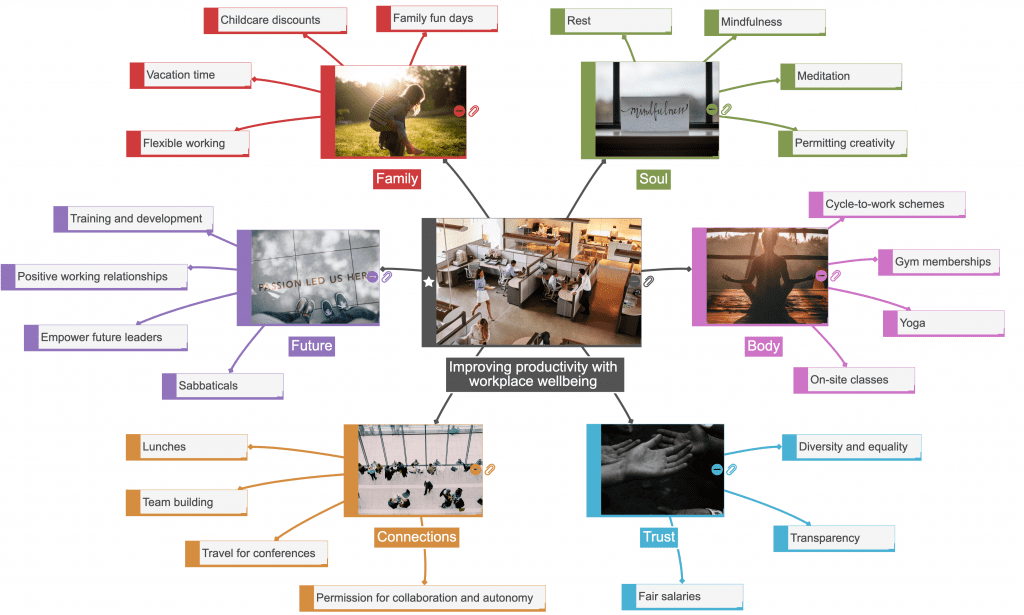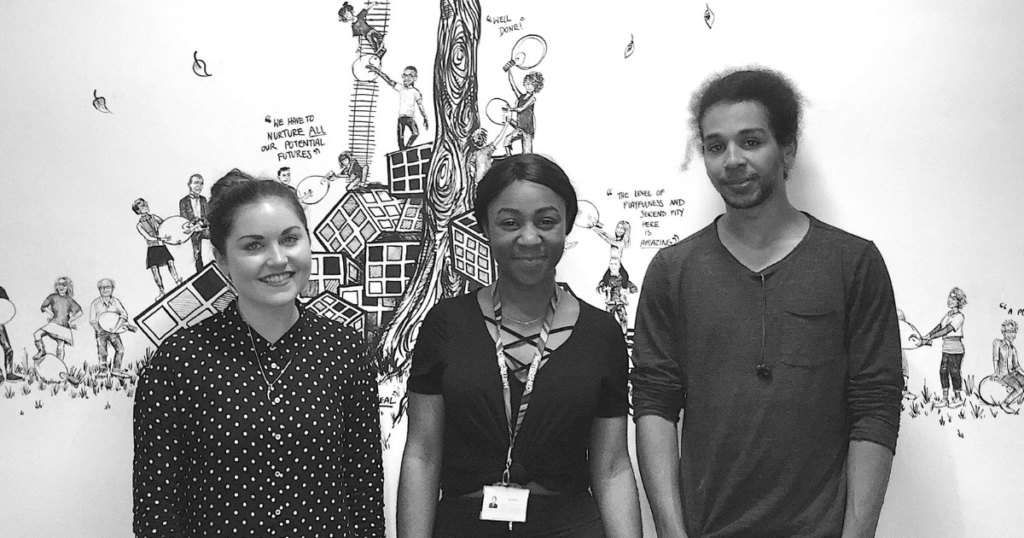Tips for cultivating a happy and productive team
Research shows that mental and physical health are the most important factors affecting workplace productivity.
Teams need to feel happy and healthy to deliver their work. However, to achieve this, employers need to introduce new strategies for encouraging better health and wellness. Whilst doing so, it’s important to improve workplace culture to safeguard and empower employees.
If you’re wondering how to create happier, healthier and more productive teams, there’s no secret sauce. Conversely, there are many ingredients for improving employee wellbeing and cultivating a healthier workplace.
Investing in wellbeing for productivity
For the body:
The impact of physical activity on wellbeing has been well researched and evidence shows there’s a strong link between the two.
Many people think of the body and mind as separate entities. However, the way you treat your body can have a great impact on your mind. Physical activity is not only an excellent way to stay fit and healthy, but it can also greatly improve your mental wellbeing.
Exercise releases endorphins to improve your mood and your body rewards you with more energy in the long run. Therefore, finding a sport, workout class or another mode of physical activity that you enjoy means you can add a healthy hobby to your weekly routine. Set realistic goals and stick to them.
Gym memberships
Some companies sponsor or subsidise gym memberships for employees. In fact, many gyms offer a corporate discount. Everyone wins!
Look into what gym memberships you could offer so that employees could save some pounds and gain some energy, strength, and fitness whilst improving their wellbeing. Consequently, their productivity will improve in the office, too.
On-site classes
Bringing exercise classes on-site makes them easier to do. You are removing key obstacles by running classes on your doorstep! Group exercise also offers another chance for employees to connect and socialise away from their desks.
If classes run during the lunch hour, employees can break up their day and reduce the time sat at a desk. In addition, they will return with a refreshed focus and even more motivation.
Yoga
By mixing core strengthening with stability, flexibility, mobility and improved posture, yoga is great for your body and an excellent way to wind down. A yoga session can be very relaxing and most finish with meditation.
Significantly, encouraging yoga practice or inviting an instructor to deliver regular sessions at your workplace could result in huge benefits by reducing and combatting stress.
Cycle-to-work schemes
Introducing cycling as a method of commuting has a range of benefits. It’s environmentally friendly, cheaper without fuel and parking costs, and cyclist commuters will probably feel calmer than when navigating rush-hour traffic by car. Most importantly, the physical activity is better for your body and mind.
Research published in the BMJ has shown that cycle commuting has staggering health benefits, reducing the risk of death and the burden of chronic conditions. Evidently, once commuters had built cycling into part of their work routine, it became an integrated part of the working week and not a chore.
Encouraging cycling with cycle-to-work schemes and other employee benefits is a great way to kick-start this healthy habit.
For the soul:
If you can cultivate a happy, calm employee environment, you will encourage happier, calmer staff members. Research shows there is a link between happiness and productivity, and it works both ways.
Ultimately, happy workers are more productive, and workers that are productive feel happier. Read more in our post on how to be happy at work.
Mindfulness
Mindfulness is a therapeutic technique that has very beneficial results for those who practice regularly.
The idea is to pay more attention to the present moment. Therefore, through mindfulness, we can reconnect with our bodies and the sensations we feel to positively change how we see ourselves, our lives and the world around us.
Setting aside some time for your team to practice mindfulness is a simple and easy addition to a working week.
Meditation
Meditation techniques encourage concentration, clarity and positivity and can reduce anxiety, depression, and pain.
As well as relieving the build-up of workplace-related stress and tension, meditation can also boost attention, awareness and decision-making skills, making it a great method to encourage in the workplace.
Permitting creativity
Many workplaces have a focus on getting more tasks finished, faster. However, the emphasis placed on high productivity can have negative impacts if employees cannot work to their full creative potential, for fear of being less productive.
LinkedIn reported that the number one soft skill that companies look for in 2019 is creativity. Giving employees permission to be creative is extremely important and can have a transformative impact on your business.
One way to do this is to encourage mind mapping using Mind Map Pro, which combines creativity, collaborative working and project management.
Rest
The importance of a good night’s sleep is well known. There’s nothing new here. Lack of sleep can have adverse effects on a person’s physical health and can impact mental clarity and focus.
However, what is new is the reason that many employees need more sleep. In a world of digital distraction, interacting with computers and devices like smartphones at night and working from home can impact and interrupt our sleeping patterns.
It’s important that employers encourage their staff to get enough rest and to implement good habits. Specifically, this can be done by discouraging emailing out of working hours to make sure they have time to recharge, recover and re-energise.
For the family:
Work is an important part of our lives, but it’s not the only part. Outside of work, most employees have people who rely on them, and everyone has a need for self-care. Help your team members look after their families or pursue hobbies and interests outside of the office.
Easing some of the pressures of family life outside of work helps improve wellbeing and productivity back in the office. Here are some ideas:
Childcare discounts
Childcare can be expensive, but you can reduce the burden for your employees. If you contribute to childcare costs with company discounts, you could take a weight off your staff members’ shoulders, helping them feeling supported.
Family fun days
Done right, a family fun day can be an inclusive way to connect your employees and the people at the centre of their lives. Firstly, do your research to find the best days or times to hold an event, then find out the age ranges of your employees’ families so you can make sure there are fun, games and activities for everyone.
Plenty of vacation time
The number of paid vacation days for staff varies across different parts of the world. By law, every company in the European Union must offer employees living there at least four weeks of paid vacation, whereas in the US, there is no statutory minimum paid vacation, and the average is 10 days per year.
One of the best things that private employers can do for long-term productivity is to ensure employees get enough paid leave to relax on holiday, explore the world, or simply to rest and re-energise at home.
Flexible working
The concept of flexible working is growing in popularity, partly due to the impact of digital technologies. The digital industry allows many of us to move away from traditional, office-based 9-5 jobs.
Flexible working should be for everyone. Additionally, it’s particularly helpful for parents and care-givers, helping them work at the best time for them.
Give your team flexibility and we can bet they will repay you with high quality work.
For the future:
Investing in employees long-term helps you to pave a successful future for every member of your team. Whether that’s through growth opportunities, office ethos or direct progression, setting out a clear journey will help build a better future whilst improving motivation and productivity day-to-day.
Training and development
Don’t underestimate the importance of training and professional development courses and opportunities. In a working environment, there’s always room for learning new skills, improving expertise and honing your craft.
Offering and funding appropriate training and development opportunities for staff members will strengthen your team and can improve an individual employee’s commitment and productivity.
Positive working relationships
It’s important to fend off the risks of a toxic working culture. This starts at the top, and positive examples set by management can filter through an entire organisation.
Encouraging transparency and a caring culture with positive working relationships between teams and more widely throughout a company will benefit everyone, allowing team members to feel safe and supported at work.
Empower future leaders
If you identify a future leader, give them responsibility and the room to develop and demonstrate their skills. If you have identified correctly, they will be eager to progress.
With permission to grow, you empower your future leaders and they will repay you with dedication, productive working and by inspiring others in their teams too.
Sabbaticals
Encourage sabbaticals or give employees the option to have a break from work to spend time doing things they love. Long-term, it will create a committed workforce who feel valued and appreciated.
For connections:
Anyone who works in a business development or partnerships role will understand the importance of building authentic connections, but is this a focus within an organisation? Not always, but it should be. Creating a sense of community in your organisation is likely to help achieve a healthier workforce.
Team building
Building friendships and connections between your employees will improve teamwork. Organising dedicated team building events and activities is particularly important if your workforce works different hours, partly remotely or is fully distributed.
Team building doesn’t need to be expensive, though. You could start with a quiz!
Lunches
Evidence suggests that eating together can bring a team closer, keep morale high and improve retention, whilst giving all levels in your organisation access to socialise with leadership figures.
Sharing meals is a key element for socialisation, and studies suggest that collaboration filters back into work. Why not put the research into practice and organise a weekly team lunch?
Travel for conferences and events
Giving a budget for your team to attend conferences and events is a win-win scenario.
Employees can learn, develop and eventually position themselves as an expert, whilst networking and representing your brand. They will return to their desks with new ideas, insights and skills, feeling energised and motivated to use their experience to freshen up their day-to-day work.
Permission for both collaboration and autonomy
People work differently from one another. We are all unique, after all. However, most jobs require a mixture of independent and group working.
For optimum productivity, employees should be given permission to be both collaborative and autonomous in their working. Giving them space to do both allows them to flourish.
For trust:
Building trust in your workplace is the best way to engage your employees. You can start by aligning words and actions, implementing everything you promise. Trust works both ways, and employees who can trust their employer will deliver with better teamwork, productivity and commitment.
Transparency from the top down
Transparency is not just about sharing information, it’s about being open, accessible and honest. In return, a transparent culture will improve interpersonal trust and enable a sharing and collaborative culture throughout all areas of a business, whilst helping individuals feel safe and reassured.
Diversity and equality in the workplace
All employers should be aiming to create a diverse and inclusive working environment with equality at its core. Diverse thinking will ultimately lead to innovation, and it is the responsibility of an employer to improve balance and equality.
Representation matters, and recognising this will improve the relationship between staff and employers.
Fair salaries
The bottom line is important, but so is paying employees what they are worth. Create processes and systems for paying salaries fairly in your organisation and competitively in your industry.
In doing so, you will attract and retain more staff, improve trustworthiness and encourage more ambition to progress.

Next steps
Take care of your employees with steps to improve their physical and mental health, ease the pressures of family life, encourage connections with one another and build trust for the company.
“According to a major study of 158,000 people across 450 employers, the healthiest workplaces are not only able to reduce absence but also save an average of 11.5 days of unproductive time per employee a year, compared to a typical workplace. That equates to employing another five people per hundred already employed.”
Ultimately, by investing in the future, an organisation can benefit today, with happier, healthier employees who are committed and productive. Everyone wins!



